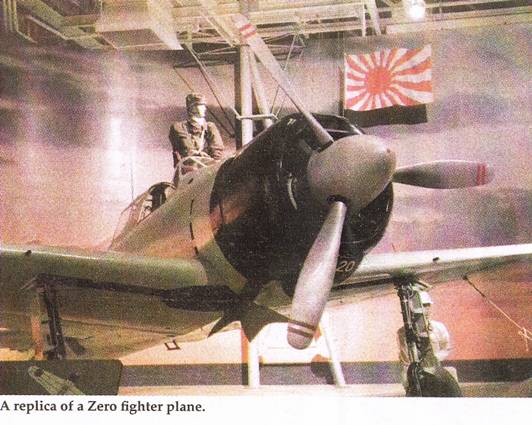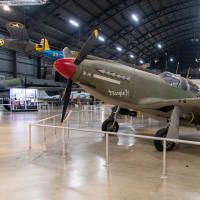
REMBERING THE BATTLE OF MIDWAY
Japanese ZERO Pilot Kaname Harada Speaks of Lessons Learned
It was been 68 years since the Battle of Midway was fought,
but 93-year-old Kaname Harada, a former Japanese Zero fighter pilot,
still remembers the action vividly.
Harada was one of 21 zero pilots who attended a June 4 symposium at
the Pacific Aviation Museum on Ford Island to commemorate the annyversary of the battle,
which is widely regarded by World War II historians
as the turning point of the Pacific campaign.
But while Harada shot down five American torpedo planes--
a barely escaped with his life--he does not consider himself so lucky.
"He sees the faces of the pilots he shot down and it's replayed over and over
in his mind and he feels is a heavy burden that he has carried all these years,"
said historian Dan King, who served as Harada's interpreter at the symposium,
which was attended by about 150 people,
"Although he won all those dogfights, he feels that, possibly, he was the loser."
Harada entered the Japanese Imperial Navy flight school in 1935 and
pursued a career as a fighter pilot because they were allowed to fly
as a"lone wolf".
He turned out to be so talented that he graduated from flight school
at the top of his class in 1937--a distinction that earned him
a pocket watch from the emperor, which he still has today.
Harada went on to provide air cover for four Japanese aircraft carriers
during Japan's Dec.7,1941,attack on Pearl Harbor,
although he did not drop any bombs or torpedos.
Six months later,Harada was assigned the job of defending the same
four Japanese carriers that had been involved in the Pearl Harbor attack--
but his time in the Battle of Midway, which lasted from June 4 to June 7,1942.
Harada's Zero fiter plane,which was heavyly armed,
but offered little protection from attack,
took off from the deck of the Soryu just as dawn was breaking on June 4.
The carrier was eventually destroyed by enemy fire.
Harada's damaged as well, forcing him to land on the Hiryu---
--the last functional Japanese carrier.
Shortly after taking off from the Hiryu in a new plane,
the carrier exploded, leaving Harada with no plane to land.
He circled the area for three hours, until his fuel ran out,
forcing him to ditch his plane in the ocean.
Finally, four hour later, around 7 in the evening,
Harada was picked up by the Japanese destroyer Makigumo.
Were it not for a stroke of luck, however, Harada said he would have been dead
by the time the ship made its rounds and found him floating in the water.
It turns out that while Harada was waiting for a new plane to be readied for him
on the deck of the Hiryu, he had put his pistol down on a nearby table.
In the commotion of battle, he forgot to pick up the weapon and take it with him
whin he boarded his new aircraft.
"When they said there's a plane ready, he rushed up and ran aut and left
the pistol on the table, and that's how he's here today,"
King told reporters.
"If he would have had that pistol with him when he was in the water,
he would have killed himself."
But when the medic on-board the Makigumo began treating him
instead of the many injured men who had lost their arms or legs,
Harada came to a horrific epiphany about the realities of war.
"The doctor said, 'No, no, you are in better shape than all these guys,
so we're gonna patch you up and put you back into battle.
The guys whose arms and legs are missing, they're basically useless,
so we're gonna leave them alone," King relayed.
"When you're involved in war, it's like we're not humans--we're like weapons;
we can be disposed of and used."
By the time the fighting was over, the U.S. Navy had inflicted roughly
2.500 casualties on the Japanese side, compared to 307 American casualties.
Harada said after returning to Japan, the military personnel who had survived
were isolated for over a month to prevent information about the devastating
loss from reaching the public.
Harada would, however, go on to fight in the Battle of Guadalcanal,
where he registered nine solo kills and 10 shared ones.
Sixty-eight years after the Battle of Midway, Harada and over 100
World War II veterans from the United States and Japan
visited the tiny coral atoll, which today is a national wildlife refuge,
to pay resupects to the soldiers who lost their lives in the conflict.
"We had Hawaiian leis and we went out on a boat and
we put the leis outon the water and he(Harada) read a speech that he had
(ここまで)




















私は英語に関してかなり未熟なひよっ子ですので、
エリス中尉の訳に対してあれ?と思うところはまずないと思います(笑
むしろこう言う意訳があるのだなと勉強になります。
私もいつかはそれなりに訳せるようになりたいなどと思ったり…
堅苦しい受験英語と違ってこう言った文だとやる気もぐんと湧きました。
もしかしたらさくらさんって、高校生?
違いますよね?だって文章が高校生とはとても思えない・・・。
と、全く別のポイントに喰いついてしまいましたが、この文章は全く難しいものではないので、英語がそんなに得意ではなくても、内容に興味がある方には理解できるのではないかと思い、さくらさんのリクエストにお答えしました。
原田要さんの話はあちこちの文章や映像で知ることができるようですが、アメリカ側の報道がどのように原田氏を語っているか、ということに興味を持たれる方も多いのではないかと思います。
この、通訳兼歴史家のダン・キングという人物が何なのか、ちょっと知りたい気もしますねw